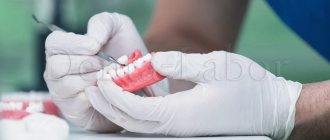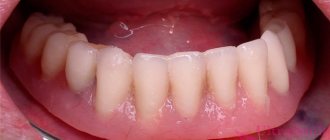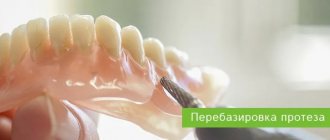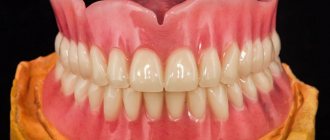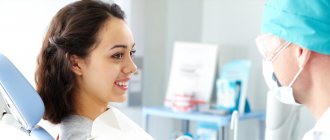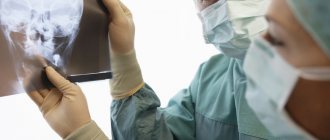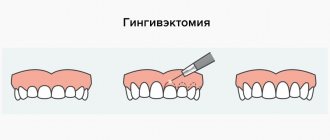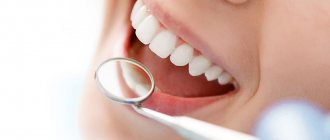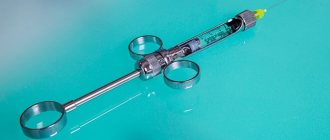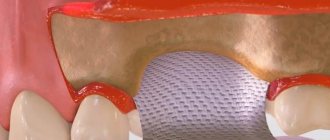- When is denture relining necessary?
- Contraindications for prosthesis relining
- Laboratory relocation
- Relining the prosthesis price
- Features of the clinical method
- Laboratory method for relining a prosthesis
Attachment of removable dentures during prolonged wear with intense loads loses functionality.
Gradual weakening of locks or hooks requires relining of the removable denture. It is not difficult to determine that you need to contact a specialist for help. During a conversation or eating, gradually progressive discomfort begins to appear. Relining the removable denture will ensure a tight fit of the structure and will completely normalize the bite. By postponing a visit to the orthodontist, people expose the oral mucosa to danger and the likelihood of injury increases.
Symptoms that should not delay a visit to the dentist
You should make an appointment with an orthodontist if:
- changes in the alveolar process of the upper jaw appear;
- the prosthesis has received damage that is not visible to a specialist, or significant flaws have appeared after prolonged wear;
- the height of the lower third of the face has undergone atypical changes. At the same time, the minimum initial deviations rapidly increase;
- The relief of the oral mucosa changes dramatically during prosthetics or after prolonged use of a stationary prosthesis.
Indications and contraindications for the procedure
Indications for relining the upper and lower dentures are the following situations:
- there are visually noticeable damages and defects on the surface of the structure,
- the alveolar process has changed shape, which is why the prosthesis is unstable and has weak fixation,
- the lower third of the face has undergone changes in height (even if minor deviations are detected),
- The print was made at a low level of quality; technical defects were revealed during operation.
That is, you need to apply for relining in situations where the prosthesis has become uncomfortable - it puts pressure on the gums or does not fit well.
Relining is not carried out if there are pronounced inflammatory processes in the oral cavity of various origins (with minor inflammation of the mucous membrane, allowing for impressions to be made, relining is permissible), if there is an allergy to the materials used (in this case, the prosthesis needs to be changed), as well as the detection of obvious significant damage prosthesis or its instability - these factors are grounds for its disposal and the manufacture of a new device.
Contraindications
Relining a removable denture is not done if:
- damage to the structure occurred due to a strong impact on a hard object or other mechanical impact that violated the integrity of the system;
- the prosthesis no longer meets the standards necessary for its continued wearing due to loss of integrity;
- there are one or more broken elements;
- anatomical retention is impaired, in which the prosthetic bed is not able to hold the prosthesis;
- The structure is unstable and can fall apart into its component parts at any moment.
The above reasons indicate the futility of relining a removable denture, since urgent production of a new system is required.
Review of correction methods or relining of dentures, indications for the procedure
If a removable denture presses, rubs, does not fit well to the jaw, or is damaged during use, do not try to fix it yourself, but immediately contact your dentist. The doctor will conduct an examination, find out the cause of the discomfort and select the optimal restoration method. Timely correction of dentures prevents serious complications and extends the service life of the products.
Advantages of the Denta-Labor team
- Many years of experience More than 20 years in the dental services market
- Modern equipment Expert class dental devices
- Denta-Labor's own training center conducts training courses for dental technicians in Moscow
- Individual approach The client’s wishes and existing orthopedic problem are taken into account
- No unnecessary additional services Completion of work according to a pre-agreed estimate
- Courier delivery We will deliver the dentures as soon as possible
Correction methods
The dentist can use two methods to correct removable orthopedic dentures. For articulation testing, the following algorithm of actions is used:
- the doctor installs the prosthesis;
- checks the reliability of fixation;
- inserts articulation paper between the teeth;
- invites the patient to close his jaws and move his teeth forward and to the sides;
- grinds paper-painted points on a removable denture with a milling cutter;
- makes a re-check and, if necessary, repeats the manipulation.
The method makes it possible to detect protruding areas of artificial teeth that interfere with chewing food and closing the jaws.
If there are gaps between the gums and the denture, bring it in for relining as soon as possible.
The basis correction occurs differently:
- the dentist removes the orthopedic structure;
- paints the mucous membrane with a chemical pencil;
- puts on the prosthesis and invites the patient to move his jaw;
- removes and checks the product;
- The painted areas are smoothed with a special device and the fitting is repeated.
When the prosthesis has metal parts, the fitting is carried out with the utmost care. The components are shaped and sanded to remove sharp edges.
If the base is cracked, the doctor selects repair options individually, focusing on the complexity of the breakdown. Most often, the rupture site is cleaned and filled with a suitable polymer. After the substance hardens, the area is polished and given the necessary relief.
Clinical method
If the prosthetic bed does not correspond to the base due to technical defects or bone tissue atrophy, the structure needs to be rebased. To correct the situation, clinical and laboratory methods are used.
- In the first case, the dentist checks the bite with articulation paper, examines the prosthesis and corrects the protruding areas.
- Afterwards, a layer of material 1 mm thick is removed from the surface of the product facing the mucosa.
- In the vestibular part of the prosthesis, carefully clean off the polish and lubricate the crowns with Vaseline.
- Self-hardening plastic is mixed. The swollen mass is applied in an even thin layer to the base, wait 15 seconds and inserted into the patient’s oral cavity.
- Excess material is squeezed onto the surface of the base in the area of the soft palate. They are carefully removed with a spatula.
- After 2 minutes, the structure is removed from the mouth and placed in the apparatus, where final polymerization occurs.
If the base is cracked, the doctor will try to repair it.
After clinical relining, the microrelief of the oral cavity is clearly displayed on the base, and the fixation of the prosthesis is significantly improved. The patient receives the finished product in 30-60 minutes.
Laboratory method
If plastic intolerance or mucosal pathology is diagnosed, the clinical method for relining cannot be used. For such patients, a laboratory method is recommended.
- An impression is made using dentol, orthocor or other modern materials. The dental technician plaster the structure with the impression in a direct way, remove it from the mouth, replace it with plastic and carry out polymerization.
- The advantage of the laboratory method is that the self-hardening plastic does not come into contact with the oral cavity in an uncured form, and the new base layer is completely no different from the previous one.
- Among the disadvantages, it is worth noting the high price and the fact that technical errors often occur with the laboratory relining method. It takes a day to repair.
Relocation technique
Orthodontists use two main types of denture relining.
- Clinical . It is limited by the patient’s intolerance to certain synthetic components that cause allergies, or chronic diseases of the oral mucosa.
- Laboratory . The most secure, reliable, convenient.
Only the attending physician chooses a technique based on the patient’s current condition, associated issues, and clinical picture.
Types of materials for correcting minor disorders
To restore a dental structure, three groups of materials are used:
- permanent hard: this is a plastic for relining removable dentures, available in two types - cold-curing acrylic and hot-hardening acrylate. Cold-curing acrylic can injure the mucous membrane, has an unpleasant taste and leads to discomfort in the mouth. Hot-cured resin is safer on soft tissue, but increases the likelihood of loss of structural stability. Duration of operation is 2-4 years,
- semi-permanent soft: represented by silicone and acrylic elastomers. Used when all design parameters are normal, but the patient feels discomfort and pain in the head. Most often, semi-permanent soft relining materials are used on the lower denture. Among the disadvantages of silicone, it should be noted: difficult adhesion to the base of the product (which requires the use of adhesive) and an increased risk of developing stomatitis. The downside of acrylic gaskets is a gradual loss of elasticity. The service life of cushioning materials of this group is, on average, six months,
- temporary soft (conditioners): used for soft relining of dentures in case of periodic inflammation of the mucous membrane when it is impossible to completely refuse to wear the structure. Tissue conditioners are designed to reduce and evenly distribute stress on damaged areas of the gums until they heal. They are particularly soft and can retain their properties for up to two weeks. If necessary, soft temporary materials are renewed, since they are characterized by increased sensitivity to cleaning agents and the ability to accumulate pathogenic microorganisms.
DENTAL PROSTHESIS ON 4 IMPLANTS - from RUR 170,000.
The price includes all procedures for installing Osstem implants (South Korea), including anesthesia and diagnostics.
Hurry up to sign up for a free consultation and fix your prices.
Call now or request a call
Opening hours: 24 hours a day - seven days a week
Of course, the laboratory method is always better - in the presence of professional equipment (furnaces, articulators) and materials, the dental technician will be able to correct the design as correctly as possible. It will be more comfortable, aesthetically pleasing and durable. But you, as a patient, will have to go without teeth for several days.
Relocation cost
| Name | Price from | |
| Relining a partial denture | excluding cost of prints | 5500 rub. |
| Relining a complete removable denture | excluding cost of prints | 5500 rub. |
| Repair of acrylic prosthesis | simple, excluding the cost of prints | 3000 rub. |
| Repair of acrylic prosthesis | average, excluding cost of prints | 3000 rub. |
| Repair of acrylic prosthesis | complex, excluding the cost of prints | 3000 rub. |
| Taking impressions | Complex | 2000 rub. |
Indications for relining the prosthesis
This procedure is usually recommended if discomfort occurs while talking or eating. It allows you to improve the fit of the structure and ensure adequate closure of the jaws.
The relocation is carried out -
- if there are defects in dentures,
- in case of poor-quality impression taking,
- deterioration of the aesthetic parameters of the dental structure,
- when the prosthesis does not fully perform its chewing function.
This procedure is also necessary if the prosthesis injures the tissues of the oral cavity.
Features of the clinical method
- Complete examination of the oral cavity, checking the integrity of the prosthesis.
- After analyzing the bite, the size of the marginal area is adjusted. The long one is cut off. Short - extended using quick-hardening plastic substances.
- A small layer of 1 mm will be removed from the prosthesis. The edge fragment loses polishing.
- Thorough impregnation of artificial elements with Vaseline.
- The boundaries of the marginal area are completely treated with a liquid polymer mixture.
- After the outer layer becomes dull, the prosthesis is put on by the patient. It is necessary to close your jaws tightly and hold in this position for a couple of minutes.
- The system is then polymerized in special equipment.
- After ten minutes of treatment, the prosthesis is removed to be adjusted manually. In the finale, he is immersed in hot water.
The advantages of clinical relining of a removable denture include the rapid elimination of existing deficiencies, as well as ideal accuracy. The disadvantages include the high porosity of the material, which reduces the hygiene of the system, and color changes.
Material used
Base resins that are used to adjust dental bridges must have certain properties. Among them are the following.
- strength;
- high resistance to abrasion;
- elasticity;
- lowest water absorption.
There are two large groups of plastics for relining removable dentures - base plastics of hot and cold polymerization. When cold, it is recommended to immerse the plastic in cold water, where it quickly hardens. But this method has its drawbacks: when relining, pores and cavities may form, and the plastic will change color.
Also, cushioning materials are divided into the following types:
- Solid constants. Used for better adherence of the base to the gums. The average duration of wearing is 5 years.
- Semi-permanent cushioning materials for soft relining. Most often they are used to correct a lower jaw prosthesis when a person begins to experience discomfort when wearing and chewing. Also, this type of plastic is suitable for those who have thinned resorbed alveolar ridge and patients with decreased bite height, since soft materials are highly elastic.
- Temporary soft (conditioners). Indispensable if the denture provokes inflammation of the soft tissues. The doctor will immediately remove it and, if necessary, apply a temporary soft pad. This is a soft material that is distributed along the gum to perform chewing functions.
After the mucous membrane has healed, you can begin to reline the clasp prosthesis or any other. The most common plastics:
- Ethacrylic, which is available in powder and liquid form. Has an opaque pink color.
- Bakryl is a high-strength hot-curing polymer. Has increased resistance to cracking and abrasion.
- Ftorax - contains fluorine, has increased strength, and is closest in color to the soft tissues of the oral cavity.
- The plastic is colorless. Suitable for patients with allergic reactions to the colored base. It is transparent and durable.
- Futur Aciyl and Future Press HP are used for the manufacture of partial and complete removable dentures.
- Protacryl-M is a cold-polymerized plastic containing fluorine rubber and a cross-linking agent. Used for making temporary splints and repairing removable dentures.
- Redont is available in three types: pink opaque, pink transparent and colorless. Durable material with the least amount of pores.
- Palapress and Palapress vario. Has many varieties of color. Good tolerance of the oral mucosa. Long term of use.
Prices for relocation vary from 2 thousand to 10 thousand rubles and depend on the level of complexity, material of manufacture and qualifications of the specialist.
Relining of removable dentures using the laboratory method
- The work is performed by a technician in a laboratory.
- The degree of wear of the prosthesis, quality of manufacture, and tightness of fit in the mouth are assessed.
- A control impression is made for transmission to the doctor.
- The surface of the prosthesis undergoes special treatment.
- A copy of the impression and the system are lowered into a ditch, after which they are filled with diluted plaster.
- The cast is taken out, and the resulting void is filled with polymerizing plastic.
- The excess is cut off, after which the product is polished.
The main advantages of the laboratory technique include the absence of contact between the mucous membrane and the plastic, a strong connection between the old and new layers, and an excellent aesthetic appearance. The disadvantages include the length of the process. The patient is forced to go without a prosthesis for several days; errors are possible that require additional time to eliminate defects.
Laboratory method
Work in the laboratory is carried out in cases where the prosthesis is manufactured for the first time and in cases of serious violations committed during manufacturing. And also with reduced bite heights. In this case, harmful toxins do not affect the mucous membranes of the mouth, and the product looks more aesthetically pleasing than with the clinical method.
Relocation stages:
- The prosthesis is removed and sent to the laboratory, where the top layer of plastic is removed.
- New dental impressions are taken from the patient.
- The old denture and the new impression are placed in a mold into which the plaster mixture is poured.
- The impression is then removed and the space is filled with a polymer material that bonds to the item.
- At high temperatures, the applied material polymerizes.
- The finished structure is removed, cleaned of excess and polished.
- The prosthesis is tried on the patient. If necessary, the bridge is adjusted again.
- If a person does not experience discomfort during installation, chews easily, closes his jaws, the relining is completed.
Relining is carried out using hot polymerization plastic
The big disadvantage of this method is the length of the wait and the need to visit the doctor several times. Production time takes from two to five days.
Frequently asked questions - answers:
Which prosthesis is better to choose - domestic or imported?
Perhaps, from an aesthetic point of view, our products are inferior, but in practice they turned out to be much stronger and more reliable than imported dentures.
Why is the denture, which I have been using for less than a year, constantly getting in the way and falling out? This has already begun to cause psychological discomfort.
The implant was simply not adjusted to the end. We advise you to do a relocation; do not worry, there is nothing painful or scary in this procedure.
Why do I need to reline the prosthesis if nothing bothers me?
Reliable fixation of the prosthesis is an extremely important condition for the full functioning of the entire dental system. And, of course, comfort. Any artificial teeth need to be looked after - cleaned and regularly shown to an orthopedic dentist.
To order denture relining in the dental laboratory Denta-Labor, send a request from the website or call the number: +7(495) 162-08-25.
Dyatlov Evgeniy Valerievich
Head of the Denta-Labor laboratory and teacher at the training center organized at the laboratory.
Graduated from Stavropol Basic Medical College.
Author of the article: Scientific team of the dental laboratory Denta-Labor
- Studied in Germany with Dr. Karl Peter Meschke in the course of complete removable prosthetics.
- I attended a course of lectures at the German Dental Academy based at BEGO (Bremen).
- Completed a week-long internship in Germany at the BEGO company on new technologies and materials for removable prosthetics.
What is relining a removable dental structure?
Most patients do not fully understand what this procedure is called denture relining. The term implies a series of manipulations aimed at eliminating and preventing minor damage to the base of the structure, correcting defects (if identified), restoring a tight fit of the dentures to the mucosa, and clarifying the boundaries. The procedure is performed directly in the doctor’s office or in a laboratory setting, depending on the situation.
In the first months after fixation of a removable denture, relining is necessary for a tight fit of the structure. Because you have had no teeth for a long time, the jaw joint has been rebuilt, and after the entire jaw system has been restored to functionality, changes in the bite gradually occur - this is why after a couple of months the denture may become uncomfortable, the jaws may not close completely. Therefore, make it a rule to visit your doctor every 2-3 months during the first year - this way you can at least slightly smooth out the inconveniences that wearing a removable structure causes.
Reviews
— Albert
I really liked the level of service and attitude of the staff.
- Eugene
They saved me, there’s no other way to put it. Thank you for the speed and decency. Everything as promised!! I recommend to all!!!
- Svetlana
This is not the first time we have used denture repair services. As always FAST AND HIGH QUALITY! Thank you for your promptness and understanding!!
— Ksenia Vladimirovna
My daughter’s denture broke on the eve of her wedding, I was very upset, but Denta-Labor managed to fix it very quickly and efficiently, thank you.
General overview
Technically, relining a removable denture is a whole complex of actions, the priority goal of which is the restoration of the functional parameters and characteristics of the structure. In some situations, adjustment is required already early after installation, which is caused by atrophic changes in the structure of bone tissue. Chewing load after a long pause can lead to deformation of certain areas of the alveolar process, which is why doctors recommend quarterly scheduled examinations in the first year after surgery.
Delivery areas:
- Altufyevo
- Bibirevo
- Biryulyovo East
- Central Administrative District
- Chertanovo
- Golyanovo
- Krasnopresnenskaya
- Kuntsevo
- Kuzminki
- Odintsovo
- Lyublino
- Medvedkovo
- Mitino
- Otradnoe
- Pavshinskaya floodplain
- Printers
- Polezhaevskaya
- River Station
- Ryazan Avenue
- SAO
- Northern Butovo
- Sokolniki
- NEAD
- SZAO
- Tushino
- Southern Administrative District
- SEAD
- South-Western Administrative District
- Voikovskaya
- Vykhino
- Company
- Zhulebino
- Aprelevka
- Dubki
- Krasnoznamensk
- Krylatskoe
- Cuban
- Nazaryevo
- Barvikha
- Vlasikha
- VNIISSOK
- Vnukovo
- Larks
Necessity of the procedure
Violation of planting density is a factor that provokes negative consequences. Firstly, lack of balance can cause damage to the replacement device, making it unsuitable for further use. Secondly, constant contact of solid elements with the mucous surfaces of the oral cavity leads to the development of inflammatory processes that will require additional treatment. Similar situations occur not only when wearing removable products, but also when installing implants - the redistribution of pressure on the tissue stimulates the regeneration process, changing the initial relief.
